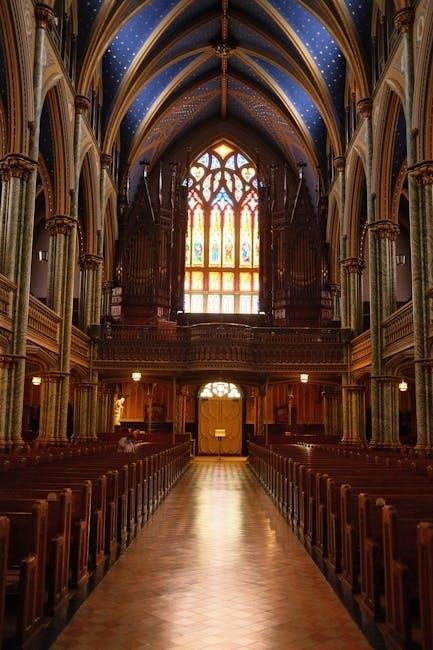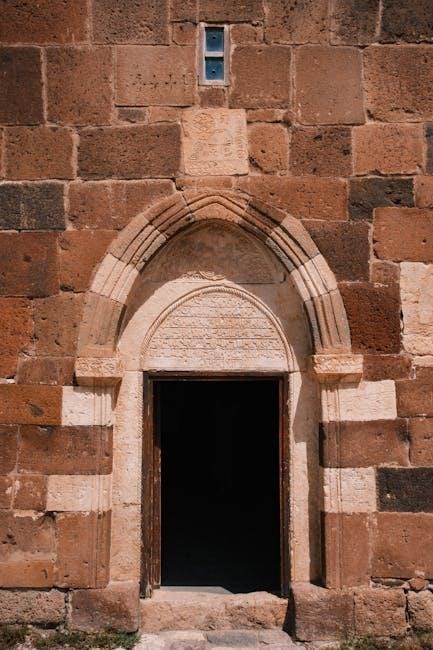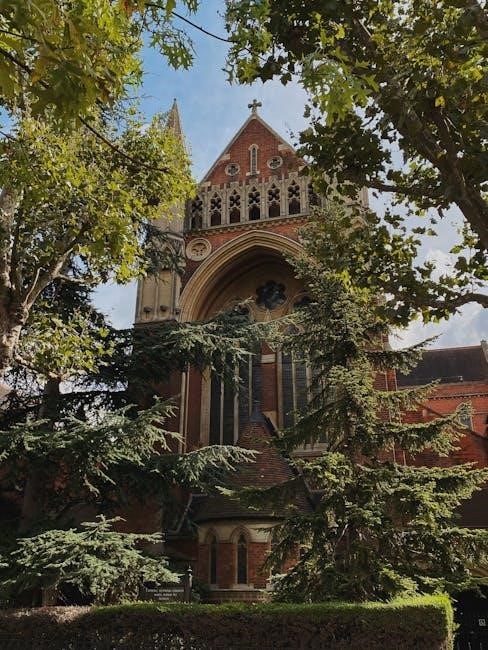
Church history explores the story of God’s work through His people, offering lessons from the past, avoiding mistakes, and fostering a sense of belonging. It bridges past, present, and future, guiding the Church’s direction today.
1.1 Definition of Church History
Church history is the chronological and thematic study of the Christian Church’s development, tracing its origins, growth, and impact across centuries. It examines the events, people, and ideas that have shaped Christianity, from the apostolic era to the modern age. Church history encompasses the rise of key doctrines, the emergence of influential leaders, and the cultural and social contexts that influenced Christian communities. By exploring the Church’s triumphs and challenges, it provides insight into God’s work through His people and the broader narrative of redemption. This field of study is not merely a record of events but a living narrative that connects believers to their spiritual heritage, offering lessons for faith, practice, and future generations.
1.2 Importance of Studying Church History
Studying church history is essential for understanding the development of Christian doctrine, practices, and institutions. It provides insights into the triumphs and challenges faced by the Church, offering lessons for modern believers. By examining the past, Christians can learn from the faithfulness and failures of earlier generations, avoiding repetition of mistakes. Church history also reveals how God has worked through His people across centuries, fostering a deeper appreciation for the global growth of Christianity. It bridges the gap between the past and present, helping believers understand their spiritual heritage and identity. Moreover, it equips individuals to address contemporary issues with a historically informed perspective. Ultimately, studying church history strengthens faith, promotes unity, and guides the Church in fulfilling its mission in an ever-changing world.
1.3 Key Themes in Church History
Church history is shaped by several key themes, including the spread of Christianity, the development of doctrine, and the interplay between faith and culture. Persecution and martyrdom in the early centuries strengthened the Church’s resolve, while ecumenical councils established foundational truths. The rise of the papacy and monasticism influenced medieval spirituality and governance. The Reformation brought calls for reform, leading to the division of Western Christianity. Missionary movements expanded the Church’s global reach, adapting to diverse cultures. Theological debates over issues like justification and authority shaped denominational identities. Throughout history, the Church has navigated tensions between tradition and innovation, unity and diversity. These themes collectively reveal the dynamic and complex journey of the Christian Church, highlighting its resilience and adaptability in fulfilling its divine mission across centuries.

Apostolic Age (1st Century)
The Apostolic Age marks the Church’s origin, beginning with Pentecost, where the Holy Spirit empowered the apostles to spread Jesus’ teachings, establishing the early Christian community and its mission.
2.1 The Pentecost and the Birth of the Church
The Pentecost, as recorded in Acts 2, signifies the birth of the Church, marking the descent of the Holy Spirit upon the apostles. This event empowered them to preach boldly, establishing the early Christian community. The Spirit’s arrival fulfilled Jesus’ promise, propelling the apostles into their mission to spread the Gospel. Pentecost is celebrated as a pivotal moment in Church history, initiating the era of the New Covenant and the expansion of Christianity beyond Jerusalem. It represents the divine enablement of believers to serve as witnesses of Christ, laying the foundation for the global spread of the faith. This event remains central to Christian theology, symbolizing the Church’s identity as a Spirit-led community.
2.2 Ministry of the Apostles
The apostles, chosen by Jesus, played a crucial role in the early Church, serving as His witnesses and ambassadors. After Pentecost, they preached the Gospel, performed miracles, and established communities of believers. Key figures like Peter, Paul, and John led the Church, guiding its growth and resolving conflicts. Their ministries were marked by persecution, yet they remained steadfast, enduring hardships for the sake of the Gospel. The apostles’ teachings, preserved in their epistles, formed the foundation of Christian doctrine and practice. Their selfless dedication and unwavering faith set a powerful example for future generations, shaping the identity and mission of the Church. Their legacy continues to inspire believers today, emphasizing the importance of living out the Gospel in word and deed.
2.3 Spread of Christianity
Christianity spread rapidly in the 1st century, fueled by the apostles’ preaching and the empowerment of the Holy Spirit. After Pentecost, the Church expanded beyond Jerusalem, reaching Judea, Samaria, and the Gentile world. The apostles, particularly Paul, undertook missionary journeys, establishing churches in cities like Corinth, Ephesus, and Rome. The Roman Empire’s infrastructure, including roads and trade networks, facilitated this spread. Early Christians shared the Gospel boldly, often facing persecution but remaining steadfast in their faith. The unity and love within the Church attracted many, while miracles and teachings validated their message. By the end of the 1st century, Christianity had spread across the Mediterranean, laying the foundation for its global reach. This period marked the transition from a Jewish sect to a universal faith, demonstrating God’s power to transform lives and societies.

Early Christianity (2nd-5th Century)
Early Christianity faced challenges like persecution, theological debates, and the rise of Church Fathers, who shaped doctrine and practices, while ecumenical councils established orthodoxy, defining the faith for centuries.
3.1 Rise of the Church Fathers
The Church Fathers were influential Christian leaders and writers who shaped the doctrine and practices of the early Church. Figures like Ignatius of Antioch, Polycarp, and Irenaeus defended the faith against heresies, while theologians such as Tertullian and Origen systematized Christian thought. Augustine of Hippo became a towering figure, blending theology with philosophy. Their writings addressed theological disputes, such as Gnosticism and Montanism, and provided guidance on sacraments like baptism and the Eucharist. The Church Fathers also played crucial roles in ecumenical councils, helping to establish orthodox beliefs. Their contributions laid the foundation for Christian theology and practice, ensuring the preservation of apostolic traditions. Their legacies continue to influence the Church, demonstrating the importance of theological reflection and leadership in shaping Christianity’s identity and mission.
3.2 Persecution and Martyrdom
During the early centuries of Christianity, believers faced intense persecution, particularly under Roman emperors like Nero, Domitian, and Diocletian. Christians were seen as a threat to the empire’s religious and political order. The Roman authorities demanded loyalty to the emperor as a divine figure, which Christians refused, leading to widespread executions. Martyrs like Stephen, the first recorded Christian martyr, and others such as Perpetua and Felicitas became symbols of faith and courage. Their testimonies inspired others to remain steadfast in their beliefs, even in the face of death. Persecution strengthened the Church’s resolve and unity, as believers saw their suffering as a participation in Christ’s Passion. The stories of martyrs were documented and revered, shaping the Church’s identity and reinforcing its commitment to the gospel. This period of trial remains a powerful testament to the enduring faith of early Christians.
3.3 Ecumenical Councils
The early Church faced numerous theological challenges, leading to the convening of ecumenical councils to establish orthodox doctrine. The First Council of Nicaea (325 AD) addressed Arianism, affirming Christ’s divinity and producing the Nicene Creed. Constantinople (381 AD) solidified the Trinity, while Ephesus (431 AD) countered Nestorianism, declaring Christ’s dual nature. Chalcedon (451 AD) further defined this, though it caused divisions. These councils were pivotal in unifying beliefs, resolving conflicts, and establishing creeds. Their decisions remain foundational for Christian theology, ensuring the Church’s doctrine aligned with apostolic teachings.

Medieval Period (6th-15th Century)
The medieval period saw the rise of the papacy, monasticism, and the Crusades, shaping the Church’s influence, theology, and culture. It was a time of both unity and conflict, defining Christianity’s role in Europe and beyond.
4.1 Rise of the Papacy
The rise of the papacy marked a significant shift in the Church’s governance, with the Bishop of Rome emerging as the central authority. This period saw the consolidation of papal power, influenced by key figures like Gregory the Great and Leo III, who strengthened the papacy’s role in both spiritual and temporal affairs. The Donation of Constantine, though later proven forged, legitimized papal claims to earthly authority. The papacy became a unifying force, countering feudal fragmentation and asserting influence over monarchs and empires. However, this rise also led to challenges, including corruption and political entanglements, which sometimes undermined its spiritual mission. Despite these issues, the papacy shaped medieval Christianity, establishing the Vatican as a focal point of religious and political power, leaving a lasting legacy on the Church’s structure and global influence.
4.2 Role of Monasticism
Monasticism played a pivotal role in preserving Christian traditions and fostering spiritual growth during the medieval period. Monasteries became centers of learning, where monks meticulously copied and preserved ancient texts, ensuring the survival of knowledge through tumultuous times. These communities also served as hubs for education, missionary work, and social service, contributing to the spread of Christianity across Europe. The Benedictine Rule, established by St. Benedict, provided a structured framework for monastic life, emphasizing prayer, work, and hospitality. Franciscan and Dominican orders later emerged, focusing on poverty, preaching, and the pursuit of holiness. Monasticism not only shaped the Church’s spiritual practices but also influenced the cultural and intellectual landscape of the medieval world, leaving a lasting legacy on Christian life and thought.
4.3 The Crusades
The Crusades were a series of religious wars initiated by the Catholic Church, primarily to reclaim the Holy Land from Muslim rule. Beginning in the late 11th century, these campaigns were marked by both religious fervor and political ambition. The First Crusade (1096–1099) successfully captured Jerusalem, while subsequent Crusades often ended in failure or further conflict. The Crusades had profound impacts on Church history, fostering a sense of unity among Christians and reinforcing the papacy’s authority. However, they also led to violence, persecution of Jews and Muslims, and strained relations between the Eastern and Western Churches. The Crusades highlighted the complex interplay of faith, power, and culture in shaping the Church’s role in the medieval world. Their legacy remains a controversial yet pivotal chapter in the history of Christianity, reflecting both the ideals and the flaws of the time.

Reformation Period (16th Century)
The Reformation Period of the 16th century was marked by a theological and political upheaval within the Church. It began as a response to corruption and doctrinal disputes, led by figures like Martin Luther and John Calvin. This movement resulted in the emergence of Protestantism, reshaping Christian practice and doctrine.
5.1 Causes of the Reformation
The Reformation of the 16th century was driven by widespread dissatisfaction with the Catholic Church’s practices and doctrines. Corruption, such as the sale of indulgences, sparked outrage among believers. Theological disputes, particularly over salvation by faith versus works, fueled the movement. Martin Luther’s 95 Theses criticized Church abuses, while John Calvin’s teachings on predestination challenged traditional views. Political factors, including the rise of nation-states seeking independence from papal authority, further strained relations. Social and economic grievances, such as heavy taxation by the Church, exacerbated tensions. The printing press spread reform ideas rapidly, enabling critics to reach a broad audience. These factors collectively created a climate of rebellion, leading to the emergence of Protestantism and a permanent divide within the Church.
5.2 Key Figures of the Reformation
The Reformation was shaped by influential leaders who challenged the Catholic Church’s doctrines and practices. Martin Luther, a German theologian, sparked the movement by publishing his 95 Theses, criticizing indulgences and emphasizing salvation by faith. John Calvin, a French reformer, developed the theology of predestination and structured Protestant worship through his Institutes. Huldrych Zwingli led reforms in Switzerland, advocating for a biblical church and opposing traditional practices. Philipp Melanchthon, Luther’s collaborator, systematized Protestant theology and facilitated dialogue with other reformers. William Tyndale played a crucial role in translating the Bible into English, making Scripture accessible to the masses. These figures, though differing in approach, collectively reshaped Christianity, laying the groundwork for Protestantism’s diverse traditions and influencing religious thought for centuries.
5.3 Impact of the Reformation
The Reformation profoundly reshaped the religious, social, and political landscapes of Europe and beyond. It led to the emergence of Protestant denominations, challenging the Catholic Church’s authority and promoting theological diversity. The emphasis on individual interpretation of Scripture and the priesthood of all believers democratized faith, empowering laypeople. The Reformation also spurred educational reforms, as literacy became crucial for reading the Bible. Politically, it destabilized the Holy Roman Empire, fostering conflicts like the Thirty Years’ War. Economically, it influenced the rise of capitalism by altering views on work and wealth. Culturally, it inspired movements in art, literature, and music. The Reformation’s legacy extends beyond religion, shaping modern ideas of individualism, free inquiry, and the separation of church and state, leaving an indelible mark on Western civilization.

Modern Period (17th-20th Century)
The Modern Period saw religious revivals, missionary expansion, and theological shifts, shaping global Christianity’s diverse landscape and influencing its contemporary practices and doctrines.
6.1 Religious Revivals
The Modern Period witnessed significant religious revivals that reshaped Christianity. The Great Awakening in the 18th century emphasized personal conversion and spiritual renewal, while the Wesleyan Revival in England focused on methodical discipleship. These movements sparked widespread evangelism, leading to increased church membership and social reforms. The 19th century saw the rise of the Businessmen’s Revival and the Welsh Revival, which emphasized prayer and community transformation. These revivals not only revitalized faith but also addressed societal issues like slavery and education. They demonstrated the power of collective spiritual awakening to inspire both personal and cultural change, leaving a lasting legacy on the Church’s growth and global influence.
6.2 Missionary Movement
The Missionary Movement emerged in the 18th and 19th centuries, driven by a renewed emphasis on spreading Christianity globally. Key figures like William Carey and Adoniram Judson pioneered efforts in Asia, while David Livingstone and Henry Morton Stanley focused on Africa. Missionaries established churches, schools, and hospitals, often blending evangelism with social reform. The movement relied on translation of the Bible into local languages and the training of indigenous leaders. Despite challenges like cultural resistance and colonial complexities, the Missionary Movement significantly expanded Christianity’s reach, fostering growth in regions like Africa, Asia, and Latin America. It also inspired movements like the Student Volunteer Movement, which mobilized thousands for global missions. The legacy of this era remains profound, shaping modern global Christianity and its diverse expressions.
6.3 Rise of Liberal Theology
The rise of liberal theology in the 19th and 20th centuries marked a significant shift in Christian thought, emphasizing reason, science, and social justice. It emerged as a response to the Enlightenment and modernity, seeking to reconcile faith with contemporary intellectual and cultural trends. Key figures like Friedrich Schleiermacher and Adolf von Harnack advocated for a more adaptive and inclusive approach to Christianity. Liberal theology focused on the ethical teachings of Jesus and the social mission of the Church, often prioritizing human experience over dogma. This movement influenced the Social Gospel, which aimed to address societal inequalities and improve living conditions. However, it also sparked debates with conservative branches of Christianity, leading to theological divides. Despite its controversies, liberal theology reshaped Christian engagement with the modern world and continues to influence progressive theological perspectives today.
Contemporary Church (21st Century)
The 21st-century Church faces global challenges like secularism and cultural shifts, yet experiences growth in regions like Africa and Asia, emphasizing mission, unity, and relevance in a changing world.
7.1 Current Issues Facing the Church
The contemporary Church faces numerous challenges, including secularism, cultural shifts, and declining attendance in Western societies; Rapid globalization and technological advancements have reshaped how the Church engages with society, often requiring adaptive strategies to remain relevant. Political polarization and societal divisions have also influenced congregations, leading to debates over inclusivity and unity. Additionally, the Church grapples with theological disputes, such as interpretations of scripture and moral issues like same-sex marriage and LGBTQ+ inclusion. Missionary efforts continue to evolve, addressing persecution in certain regions while navigating cultural sensitivities. The rise of digital platforms has introduced both opportunities and challenges, as the Church seeks to balance traditional practices with modern communication. These issues highlight the need for the Church to remain agile and compassionate in addressing the complexities of the 21st century.
7.2 Global Growth of Christianity
Christianity is experiencing remarkable growth globally, particularly in the Southern Hemisphere. Regions like Africa, Asia, and Latin America are witnessing exponential increases in Christian populations, shifting the faith’s demographic center from the West. This expansion is driven by missionary efforts, evangelism, and the rise of indigenous churches. The global Church now reflects diverse cultural expressions, blending traditional teachings with local practices. Despite challenges, Christianity remains the world’s largest religion, with projections indicating continued growth in developing nations. This shift underscores the dynamic and adaptive nature of the faith, as it flourishes in new territories while facing decline in historically Christian areas.
7.3 Future Directions
The future of Christianity lies in its ability to adapt to global changes while remaining true to its core teachings. Technology will play a pivotal role, enabling greater outreach and unity among believers. The Church must address modern challenges like secularism, moral relativism, and cultural shifts. Evangelism and mission work will continue to drive growth, particularly in regions where Christianity is expanding rapidly. There is a growing emphasis on social justice, environmental stewardship, and interfaith dialogue. The rise of indigenous leadership in Africa, Asia, and Latin America will shape the global Church’s direction. Additionally, the integration of digital platforms for worship and community building will be crucial. The Church must also prioritize doctrinal clarity and unity amid diverse interpretations. By embracing these opportunities and challenges, Christianity can thrive, fulfilling its mission to spread the gospel to all nations.
Church history reveals God’s ongoing work through His people, offering timeless lessons and inspiration. It underscores the Church’s enduring purpose and divine guidance, shaping its identity and mission for the future.
8.1 Summary of Key Points
Church history is a profound journey through God’s interaction with humanity, showcasing His faithfulness and redemption. From the Apostolic Age to the modern era, the Church has grown through persecution, theological debates, and revivals. The Reformation restored biblical truths, while modern movements emphasized global missions and theological diversity. Today, the Church faces challenges like secularism and cultural shifts but continues to thrive globally. Studying this history provides lessons on perseverance, unity, and the enduring power of the Gospel. It reminds believers of their spiritual heritage and equips them for future challenges, ensuring the Church remains a beacon of hope and truth in an ever-changing world.
8.2 Reflections on the Future
The future of the Church lies in its ability to adapt to a rapidly changing world while remaining rooted in timeless biblical truths. Challenges such as secularism and cultural shifts demand a renewed focus on evangelism and discipleship. Technological advancements offer opportunities for global outreach, enabling the Gospel to reach unprecedented audiences. The Church must also prioritize unity amid diversity, fostering collaboration across denominations and cultures. As Christianity continues to grow globally, particularly in the Global South, the Church will need to address issues like religious persecution and societal pressures. By learning from its past, the Church can embrace innovation while maintaining its core mission. Ultimately, the future holds hope, as God remains faithful to His people, guiding them toward a brighter tomorrow.